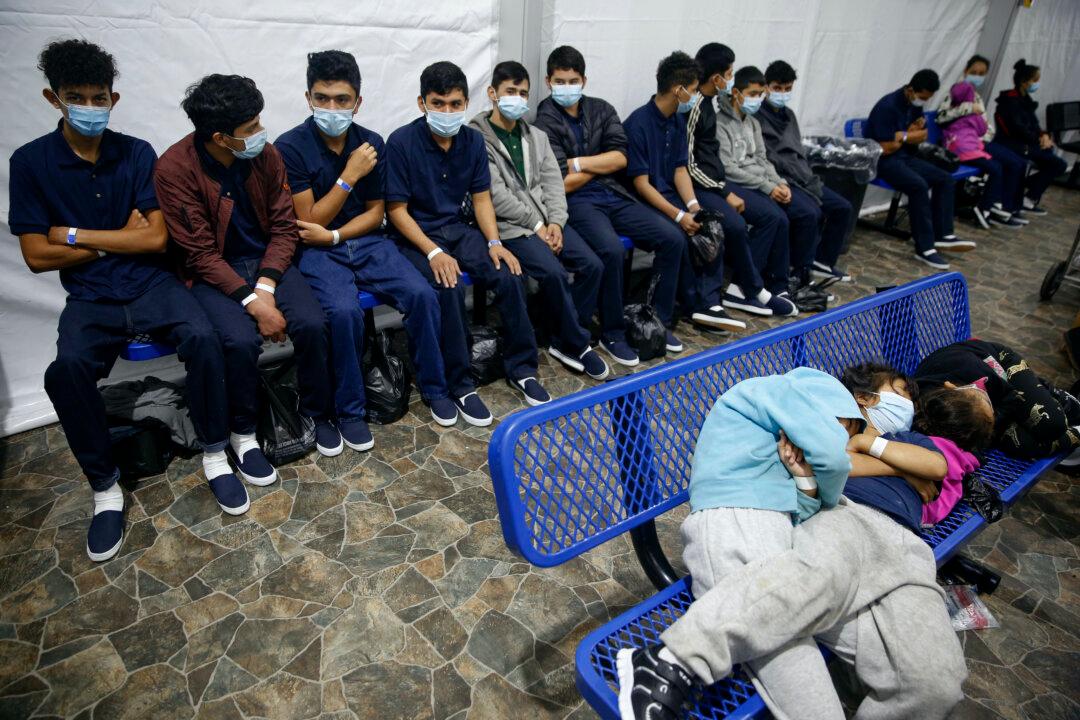An internal inspection uncovered numerous shortcomings within the vetting processes the U.S. Department of Health and Human Services (HHS) used when placing unaccompanied minor aliens with adult sponsors inside the United States.
The Office of Refugee Resettlement (ORR), is the HHS entity responsible for caring for “unaccompanied children”—which here refers to minors with no lawful immigration status who arrive in the United States without a parent or guardian. ORR operates facilities to care for these children until they can either be placed with an adult sponsor inside the United States, they age out of the system, or their immigration case is adjudicated.
The HHS IG office was tasked with reviewing how ORR handled sponsor screenings and post-release follow-ups for minors it took in between March and April of 2021.
According to the IG report, in 16 percent of case files, one or more of the required items in the sponsor safety screening checklist lacked any documentation indicating that the checks were conducted.
In 35 percent of the case files reviewed, ORR officials did not have fully legible identification records for unaccompanied child sponsors.
In 19 percent of cases where a sponsor required an FBI fingerprint check or a child abuse and neglect registry check, the IG report found indications the child in the case was released to the sponsor while the results of these background checks were still pending.
In 22 percent of cases, ORR officials did not conduct follow-up safety and well-being calls on time. These follow-up calls are supposed to occur between 30 and 37 days after a child is released to an unaccompanied child sponsor. The median follow-up time for these late calls was 122 days, with the longest delay being 324 days.
In 18 percent of cases, the follow-up calls were conducted but not properly documented in their corresponding case files.
The IG report concluded that ORR officials did not conduct mandatory home studies in at least two cases. In four cases for which no mandatory home study was required and no discretionary home study was performed, inspectors found “concerning information documented in children’s case files regarding sponsors’ living arrangements,” including three instances in which address checks found vacant homes or nonresidential addresses.
In 5 percent of the cases reviewed, inspectors found records for unaccompanied child sponsors were not updated with necessary information about sponsorship outcomes. In one case, a sponsor notified police that the 15-year-old alien minor they were sponsoring had gone missing in the middle of the night without any belongings or known contacts in the United States, however, no notes were added to this sponsor’s file and he went on to sponsor two more children through the program. In another case, the whereabouts of a three-year-old child who had been released to an unrelated sponsor were unknown.
“Overall, staff identified more than 10 children who were no longer residing with their sponsors shortly after children were released from ORR care. Only five of these children’s sponsor records noted this concerning outcome and contained related flags indicating concern about the suitability of the sponsor. It is possible that the remaining five children had legitimate reasons for no longer residing with the sponsor; however, information about the reasons for a change in the children’s living situation was not always noted in the children’s case files,” the IG report states.
The IG report calls for ORR to implement safeguards to make sure safety screenings are properly completed and ensure appropriate follow-ups and record-keeping for unaccompanied child sponsor records.
“[The IG report] covers two months in early 2021, during an unprecedented influx,“ HHS spokesman Jeffrey Nesbit said in an emailed statement to NTD News on Thursday. ”The overwhelming majority of findings and recommendations address records management and documentation issues that ORR has already improved through training, monitoring, technology, and evaluation.”
Mr. Nesbit said the steps ORR has taken “not only align with the report’s recommendations but go further, including dramatically expanding access to post-release services for children released from ORR, increased sponsor vetting, and increased coordination between HHS and Department of Labor to aggressively protect against any abuse.” He said these changes have prioritized child welfare and safety while minimizing the time children spend waiting in congregate care settings.HHS Facing Lawsuit Following Murder Case
HHS is facing a lawsuit alleging negligence in the sponsor placement for a minor illegal immigrant suspect played a contributing role in the death of Kayla Hamilton, a 20-year-old U.S. citizen murdered in Aberdeen, Maryland, in July of 2022.The primary suspect in Ms. Hamilton’s death is a minor illegal immigrant with suspected ties to the El Salvadoran MS-13 street gang. ORR officials had reportedly interacted with the suspect before releasing him to a sponsor within the United States.
The lawsuit, being pursued by Ms. Hamilton’s mother—Tammy Nobles—alleges the murder suspect was detained while trying to cross the U.S. southern border but was later permitted to enter the United States through what the family alleges were acts of negligence in the screening process.
The lawsuit alleges Department of Homeland Security employees failed to take several precautions when they first encountered the murder suspect at the U.S. southern border, including checking him for gang-related tattoos or contacting the government of El Salvador to confirm whether he had gang affiliations. The lawsuit further alleges wrongdoing by HHS employees for placing the murder suspect with a non-verified sponsor who was not a family member of the suspect.
California-based attorney Brian Claypool, who is representing Ms. Nobles in the lawsuit, has alleged that after the murder suspect was placed with a sponsor inside the United States, he ran away and ended up in Maryland, where he rented a room with Ms. Hamilton from a landlord who is also allegedly in the United States illegally.
Among other questions, Mr. Jordan’s subpoena also asks HHS to disclose how many sponsors have been rejected because they had a prior conviction for murder, child abuse, neglect, or a conviction related to the possession or distribution of sexually exploitative materials involving children. In the inverse, the subpoena also calls on HHS to reveal how many sponsor applications have been approved despite these specified types of convictions.







